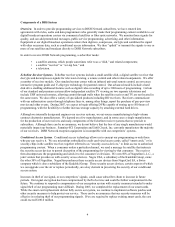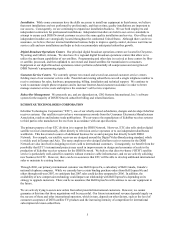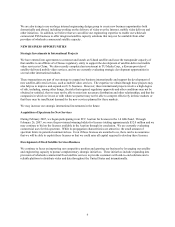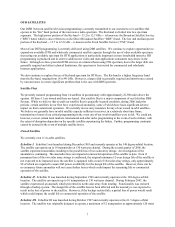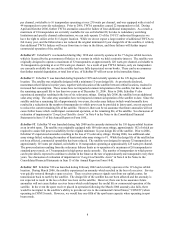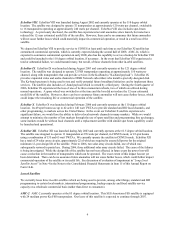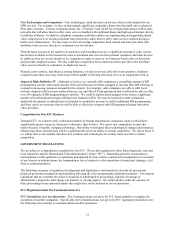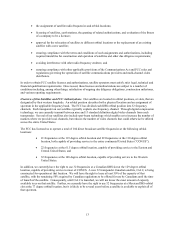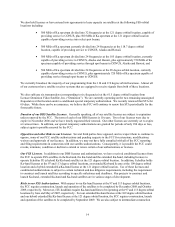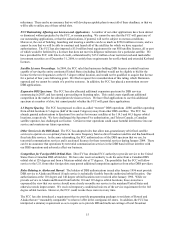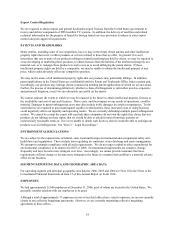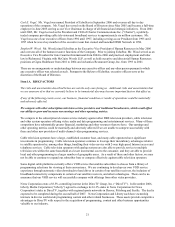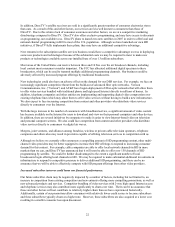Dish Network 2005 Annual Report Download - page 22
Download and view the complete annual report
Please find page 22 of the 2005 Dish Network annual report below. You can navigate through the pages in the report by either clicking on the pages listed below, or by using the keyword search tool below to find specific information within the annual report.12
New Technologies and Competitors. New technologies could also have an adverse effect on the demand for our
DBS services. For example, we face an increasingly significant competitive threat from the build-out of advanced
fiber optic networks. Verizon Communications, Inc. (“Verizon”) and AT&T have begun deployment of fiber-optic
networks that will allow them to offer video services bundled with traditional phone and high speed Internet directly
to millions of homes. In addition, telephone companies and other entities are implementing and supporting digital
video compression over existing telephone lines which may allow them to offer video services without having to
build a new infrastructure. We also expect to face increasing competition from content and other providers who
distribute video services directly to consumers over the Internet.
With the large increase in the number of consumers with broadband service, a significant amount of video content
has become available on the Internet for users to download and view on their personal computers and other devices.
In addition, there are several initiatives by companies to make it easier to view Internet-based video on television
and personal computer screens. We also could face competition from content and other providers who distribute
video services directly to consumers via digital air waves.
Mergers, joint ventures, and alliances among franchise, wireless or private cable television operators, telephone
companies and others also may result in providers capable of offering television services in competition with us.
Impact of High Definition TV. Although we believe we currently offer consumers a compelling amount of HD
programming content, other multi-channel video providers may be better equipped to increase their HD offerings to
respond to increasing consumer demand for this content. For example, cable companies are able to offer local
network channels in HD in more markets than we can, and DirecTV has announced that it will soon be able to offer
over 150 channels of HD programming by satellite. We could be further disadvantaged to the extent a significant
number of local broadcasters begin offering local channels in HD. We may be required to make substantial
additional investments in infrastructure to respond to competitive pressure to deliver additional HD programming,
and there can be no assurance that we will be able to effectively compete with HD program offerings from other
video providers.
Competition for Our ETC Business
Through ETC, we compete with a substantial number of foreign and domestic companies, many of which have
significantly greater resources, financial or otherwise, than we have. We expect new competitors to enter this
market because of rapidly changing technology. Our ability to anticipate these technological changes and introduce
enhanced products expeditiously will be a significant factor in our ability to remain competitive. We do not know if
we will be able to successfully introduce new products and technologies on a timely basis in order to remain
competitive.
GOVERNMENT REGULATIONS
We are subject to comprehensive regulation by the FCC. We are also regulated by other federal agencies, state and
local authorities and the International Telecommunication Union (“ITU”). Depending upon the circumstances,
noncompliance with legislation or regulations promulgated by these entities could result in suspension or revocation
of our licenses or authorizations, the termination or loss of contracts or the imposition of contractual damages, civil
fines or criminal penalties.
The following summary of regulatory developments and legislation is not intended to describe all present and
proposed government regulation and legislation affecting the video programming distribution industry. Government
regulations that are currently the subject of judicial or administrative proceedings, legislative hearings or
administrative proposals could change our industry to varying degrees. We cannot predict either the outcome of
these proceedings or any potential impact they might have on the industry or on our operations.
FCC Regulation under the Communications Act
FCC Jurisdiction over our Operations. The Communications Act gives the FCC broad authority to regulate the
operations of satellite companies. Specifically, the Communications Act gives the FCC regulatory jurisdiction over
the following areas relating to communications satellite operations:




